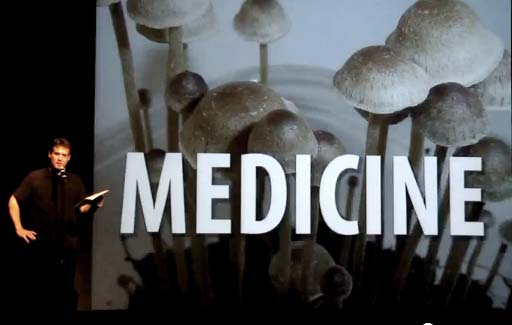Baltimore author Michael M. Hughes recently presented his talk on the history of magic mushrooms and their active ingredient, psilocybin for the Ignite Baltimore lecture series, sharing interesting and not-so-well-known information from ancient history, popular culture, and cutting edge neuroscience. Michael previously wrote a Baltimore City Paper cover story on the Johns Hopkins Psilocybin Studies – “a rigorous, scientific attempt to determine if drugs like psilocybin and LSD, demonized and driven underground for more than three decades, can facilitate life-changing, transformative mystical experiences.”
“…Tonight we’re going to talk about the most magical mushrooms of all, of the genus Psilocybe, which contain the psychoactive compounds psilocybin and psilocin. They are found on every continent except Antarctica and nearly every climate, frequently following human activity, growing in disturbed soil and the manure of our cattle. Because of their unique ability to alter human consciousness, they are often considered sacred or even gods in their own right.”
Continue reading “Teonanácatl: The Secret History of Magic Mushrooms” at michaelmhughes.com.
Mike Hughes’ video presentation of “Teonanácatl” for Ignite Baltimore.
Sacred Intentions: Inside The Johns Hopkins Psilocybin Studies
By Michael M. Hughes, Baltimore City Paper, 10/8/2008
Sandy Lundahl lies on a couch, her eyes covered with a dark cloth mask. She’s listening to classical music through enormous headphones: Brahms’ Symphony No. 2, the “Kyrie” from Bach’s Mass in B Minor, Barber’s Adagio for Strings. An hour earlier, she had swallowed two blue capsules containing close to 30 milligrams of psilocybin, the primary active chemical in Psilocybe cubensis and other “magic” mushrooms, and she’s already well on her way on a trip into the hidden spaces of her psyche.
Lundahl, a 55-year-old self-described skeptic and health educator from Bowie, is looking for God.
Two experienced guides are with her in the room, monitoring her: Mary Cosimano, a clinical social worker, and William “Bill” Richards, a white-haired, 68-year-old psychiatrist and scholar of comparative religion. He’s sitting cross-legged on the carpet in front of the couch, ready to help Lundahl–to talk her out of any negative trips, to help her remain focused on the scenes unfolding behind the mask, to offer a drink or some fruit or escort her to the bathroom. The space resembles a clean, warm, but decidedly offbeat living room. The lighting is spare and soft, emanating from two lamps. A bookshelf holds a variety of picture books and well-known spiritual and psychological classics like Freud’s The Interpretation of Dreams and The Varieties of Religious Experience by William James. Above the books sits a wooden sculpture of Psilocybe mushrooms. Behind the couch are a Mesoamerican mushroom stone replica and a statue of a serene, seated Buddha. An eye-popping abstract expressionist painting hangs on the wall, an explosion of color and intersecting lines.
This isn’t a metaphysical retreat center in San Francisco, or the Manhattan office of a New Age therapist-cum-shaman. Lundahl’s first psychedelic experience is taking place in the heart of the Behavioral Biology Research Center building at the Johns Hopkins Bayview campus in Southeast Baltimore, in a room affectionately referred to by both the scientists and the volunteers as the “psilocybin room.” She’s taking part in the first study of its kind since the early ’70s–a rigorous, scientific attempt to determine if drugs like psilocybin and LSD, demonized and driven underground for more than three decades, can facilitate life-changing, transformative mystical experiences.
Continue reading “Sacred Intentions: Inside The Johns Hopkins Psilocybin Studies” at Baltimore City Paper.

